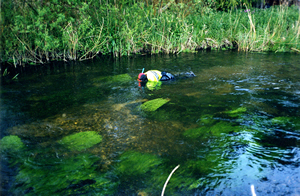 Species distribution results from chance, history (e.g. species dispersal), environmental variability (e.g. nutrient supply), natural selection, and species interactions.
Species distribution results from chance, history (e.g. species dispersal), environmental variability (e.g. nutrient supply), natural selection, and species interactions.
Species diversity gives us some information about the structure of species distribution. We concentrate mostly on aquatic vascular plants, macroinvertebrates and salmonids using spatial surveys, experiments and long term monitoring.
One of our main study sites is the research station at Glensaugh, located in north-east Scotland (Long 2º 33’ W, Lat 57º 55’ N). The catchment area of the studied streams (Birnie Burn and Cairn Burn) is 1.76 km2, within a 240-450 m elevation range. Annual average precipitation is 1040 mm and evapotranspiration 300 mm. The area lies just to the North of the Highland Boundary Fault, with soils of the Strichen Association developed on glacial drifts. At the top of the catchment the soils are mainly hill peat (2 m deep on average), whilst at lower altitudes freely-drained humus iron podzols predominate. The stream drains incised valleys of rounded hilltops. Small surface water flushes on the main hill-slope feed the main stream. The catchment is used for hill farming: mixed sheep and cattle. The vegetation cover is predominantly grass and heather with rushes growing in the flushes and bracken on the hill slope along the stream. The management of the land includes the burning of the heather (10-12% of surface area yearly target). Part of the catchment was used to run productivity experiments for grazing animals in the late 1970s and early 1980s (calcium carbonate, nitrogen and phosphorus amendments).
Our research in this area focuses on:
Quantifying the role of environmental variability, spatial connectivity and complexity on species distribution at different scales: from river reach to river networks
Testing hypotheses about the potential underlying mechanisms that could generate the observed distribution patterns using species life history characteristics (e.g. morphology, size, reproduction, dispersal, ecophysiology)
Who is working in this area?
- Benoît Demars
- Nikolai Friberg
- Jenni Stockan
Jenny Bergfur - Claire Abel
- Lynne Johnston
|
Updated: 23 Jan 2024, Content by: MC
|

